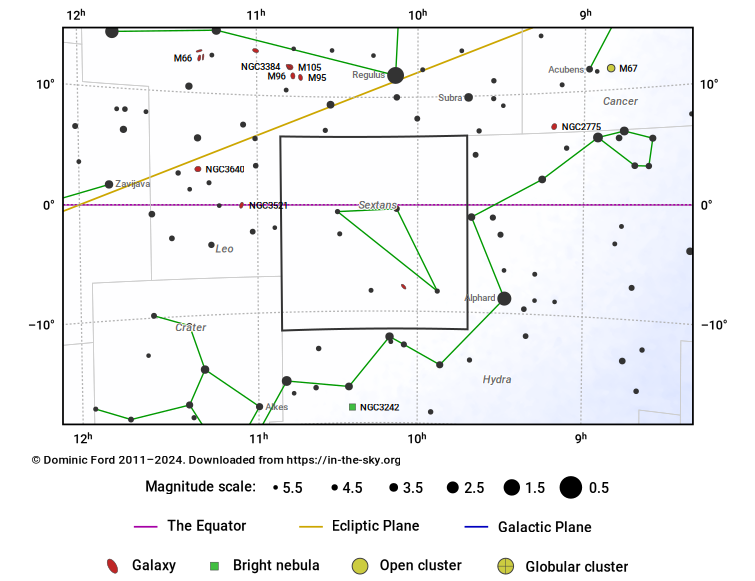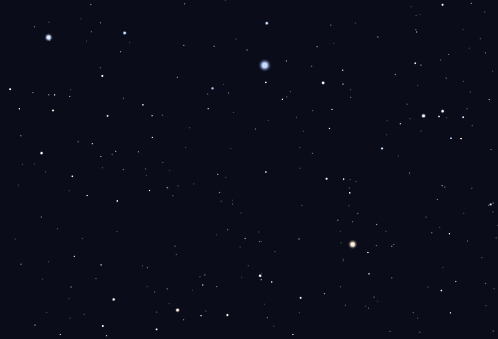The Constellation Sextans
Sextans is a faint equatorial constellation which appears highest in the evening sky in the months around February.
It was introduced by the Polish astronomer Johannes Hevelius in 1687, covering a dark patch of sky immediately south of Leo, and represents a sextant, an instrument used to measure the positions of stars. Specifically, it represents Hevelius's own sextant, which was destroyed by a fire at his observatory in Danzig in 1679.
Its brightest star is of magnitude 4.5, and it contains no bright deep sky objects.
Hover the pointer over the name of an object to highlight its position on the starchart to the right, or click to see more information.
| Stars | Open Clusters | Globular Clusters | Galaxies |
| α-Sex (mag 4.5) | NGC 3115 (mag 9.1) | ||
| β-Sex (mag 5.1) | NGC 3166 (mag 10.6) | ||
| γ-Sex (mag 5.1) | NGC 2974 (mag 10.9) | ||
| δ-Sex (mag 5.2) | NGC 3169 (mag 10.9) | ||
| ε-Sex (mag 5.2) | NGC 3423 (mag 11.2) | ||
| HIP 51046 (mag 5.6) | NGC 2967 (mag 11.6) | ||
| 18-Sex (mag 5.6) | NGC 3044 (mag 11.9) | ||
| HIP 47960 (mag 5.6) | NGC 3055 (mag 12.1) | ||
| 19-Sex (mag 5.8) | NGC 3156 (mag 12.3) | ||
| 41-Sex (mag 5.8) | NGC 3365 (mag 12.6) | ||
| HIP 52948 (mag 5.8) | NGC 3090 (mag 12.6) | ||
| 17-Sex (mag 5.9) | NGC 3375 (mag 12.6) | ||
| SS Sex (mag 5.9) | NGC 2990 (mag 12.8) | ||
| HIP 52863 (mag 5.9) | NGC 3361 (mag 12.8) | ||
| HIP 48519 (mag 5.9) | NGC 2980 (mag 13.0) | ||
| HIP 53035 (mag 6.0) | NGC 3110 (mag 13.0) | ||
| 7-Sex (mag 6.0) | NGC 3325 (mag 13.0) | ||
| 6-Sex (mag 6.0) | IC 651 (mag 13.1) | ||
| HIP 51302 (mag 6.0) | IC 575 (mag 13.2) | ||
| HIP 50292 (mag 6.1) | NGC 3340 (mag 13.2) | ||
| 35-Sex (mag 6.1) | NGC 3023 (mag 13.5) | ||
| HIP 49293 (mag 6.1) | NGC 3035 (mag 13.5) | ||
| 14-Sex (mag 6.2) | IC 630 (mag 13.5) | ||
| HIP 49900 (mag 6.2) | NGC 3385 (mag 13.6) | ||
| 4-Sex (mag 6.2) | NGC 3321 (mag 13.7) | ||
| 33-Sex (mag 6.3) | IC 600 (mag 13.7) | ||
| 36-Sex (mag 6.3) | NGC 3246 (mag 13.7) | ||
| HIP 50939 (mag 6.3) | NGC 3360 (mag 13.7) | ||
| HIP 50584 (mag 6.3) | NGC 3165 (mag 13.9) | ||
| 26-Sex (mag 6.3) | NGC 3018 (mag 13.9) |




